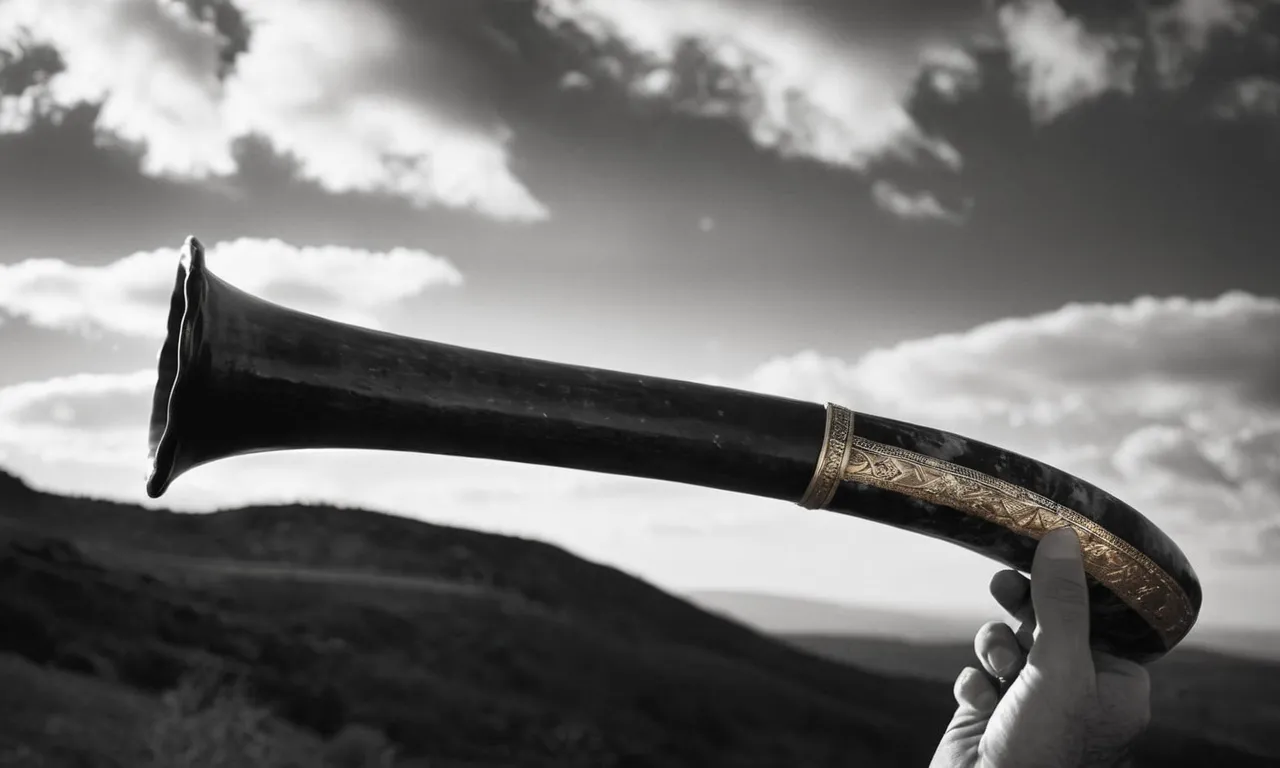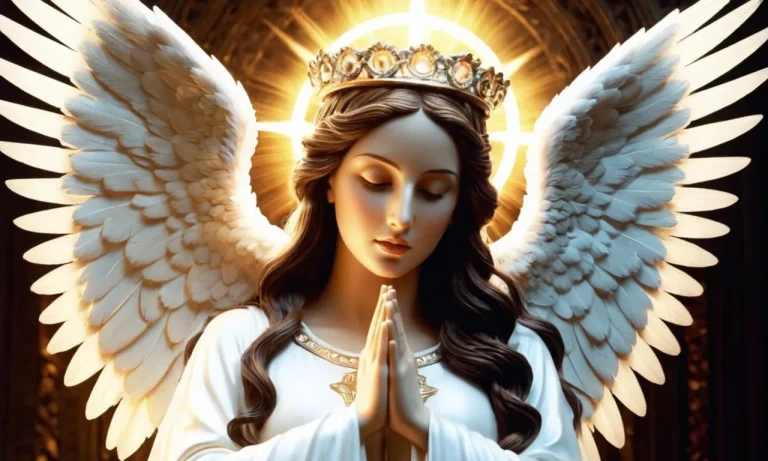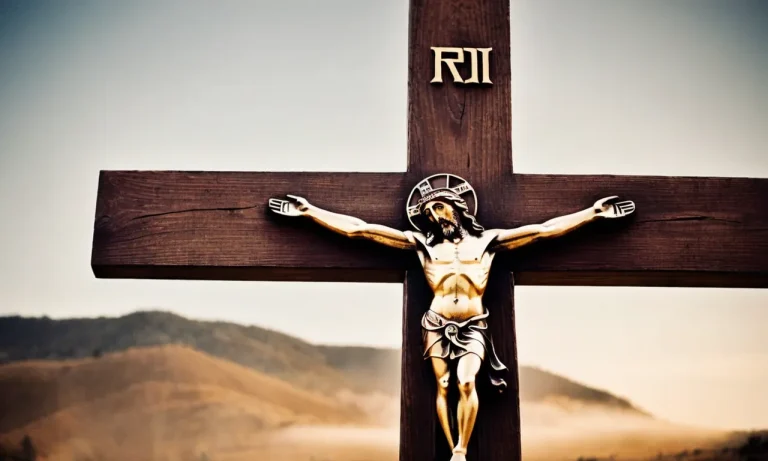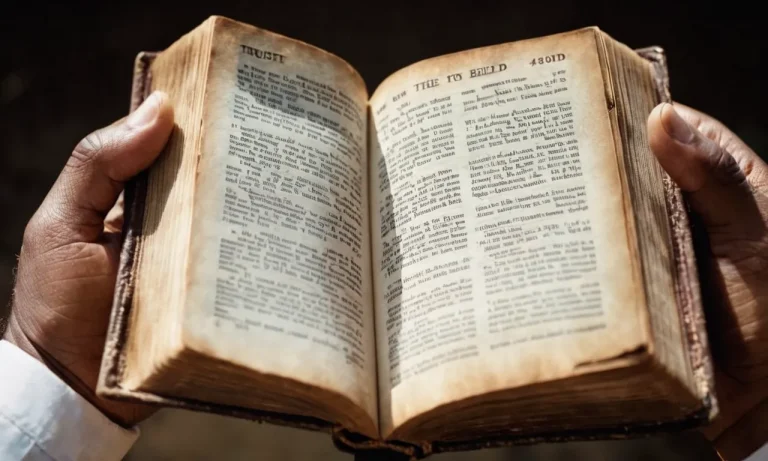Who Blew The Shofar In The Bible
The blowing of the shofar, a ram’s horn used as a musical instrument, holds deep spiritual meaning in the Bible and Jewish tradition. If you’re looking for a quick answer, the shofar was most prominently blown by the priests, including Aaron and his descendants, to signal important events and holidays.
But that’s just scraping the surface of this rich biblical symbol.
In this comprehensive article, we’ll explore the varied examples of shofar blowing found in the Bible. We’ll look at the purposes, events, and key figures associated with sounding the shofar, from the walls of Jericho to Rosh Hashanah celebrations.
Read on for a blow-by-blow account of the history and meaning behind this iconic horn.
The First Mentions of the Shofar
The shofar, a ram’s horn used as a musical instrument, is first mentioned in the Bible during the Exodus from Egypt. The Book of Exodus describes how God instructed Moses to have two silver trumpets made that would be used to summon the community and set the camps in motion.
However, the shofar is also mentioned as being sounded before the Israelites entered into battle.
The first mention of the shofar is in Exodus 19, when the Israelites arrived at Mount Sinai. Exodus 19:16-19 describes the scene: “On the morning of the third day there was thunder and lightning, with a thick cloud over the mountain, and a very loud trumpet blast. Everyone in the camp trembled.
Then Moses led the people out of the camp to meet with God, and they stood at the foot of the mountain. Mount Sinai was covered with smoke, because the Lord descended on it in fire. The smoke billowed up from it like smoke from a furnace, and the whole mountain trembled violently.
As the sound of the trumpet grew louder and louder, Moses spoke and the voice of God answered him.”
Here, the “very loud trumpet blast” refers to the sounding of the shofar. The shofar was blown to summon the Israelites to the foot of Mount Sinai and to create an atmosphere of awe and trembling as God’s presence descended on the mountain.
The next mention of the shofar is in Exodus 19:13, when Moses tells the people that when they hear the long blast of the shofar, they are to come up to the mountain. Again, the shofar is used as a signaling device.
The Shofar in Battle
The first mention of the shofar being used in battle is in Joshua 6, when the Israelites marched around the walls of Jericho for seven days. Joshua 6:4 states: “Have seven priests carry trumpets of rams’ horns in front of the ark.
On the seventh day, march around the city seven times, with the priests blowing the trumpets.”
Here, the trumpets of rams’ horns refer to shofars. The shofars accompanied the ark of the covenant as the Israelites circled Jericho, eventually causing the city walls to fall down miraculously.
After this incident, the shofar is repeatedly mentioned as being used to summon the Israelites to battle and to terrify their enemies. Judges 3:27, 6:34, and 7:8 all describe the shofar being blown to muster the Israelite army. The sound of the shofar struck fear in opposing armies.
1 Samuel 13:3 also notes: “Jonathan attacked the Philistine outpost at Geba, and the Philistines heard about it. Then Saul had the trumpet blown throughout the land and said, ‘Let the Hebrews hear!’” The trumpet referred to here is the shofar.
So the first biblical mentions of the shofar are as a signaling instrument—to summon the people before meeting God at Sinai, to call them to battle, and to strike fear in the hearts of Israel’s enemies. The shofar was a powerful and emotive instrument from its very first uses.
The Shofar in Battle
The shofar has played an important role throughout Israel’s history, often being used in times of war to rally the troops and strike fear into the hearts of enemies. Here are some key examples of how the shofar was blown in battle in the Bible:
The Battle of Jericho
One of the most famous stories involving the shofar is the Battle of Jericho in Joshua 6. God instructed Joshua to have seven priests carry rams’ horn trumpets (shofars) and march around the city once a day for six days.
On the seventh day, they were to march around Jericho seven times while the priests blew the trumpets. After the seventh round, the people shouted and the walls of Jericho miraculously collapsed, allowing the Israelites to charge in and capture the city.
The blasting of the shofars instilled fear into the hearts of Jericho’s defenders, while rallying and inspiring the Israelite troops who trusted in God’s power and deliverance. This story vividly demonstrates how the shofar was used in biblical times to direct troops in battle and pave the way for victory.
Gideon’s Battle Against the Midianites
In Judges 7, Gideon led a small army of 300 Israelites against a vast Midianite camp. God devised a clever battle strategy for Gideon’s men to frighten the enemy using shofars and torches. Under the cover of night, Gideon’s army surrounded the Midianite camp and at Gideon’s signal, all 300 men blew their shofars and smashed their jars, revealing the torches inside.
The blaring shofars accompanied by the sudden lights threw the Midianites into a panic. They were so frightened that they turned and attacked each other in the confusion. Once again, the shofar sounded as a rallying cry for Israel and a weapon to terrify their opponents.
Hezekiah’s Plea for Deliverance
When the Assyrian king Sennacherib besieged Jerusalem during Hezekiah’s reign (2 Chronicles 32), the king commanded the priests and Levites to stand on the city walls and blow their trumpets (shofars) mightily along with prayers and songs to God.
This blowing of shofars was an appeal to God for deliverance while also discouraging the Assyrian attackers. That very night, the Angel of the Lord struck down 185,000 Assyrians, forcing Sennacherib to withdraw in defeat. The shofar blast was a battle cry for divine intervention.
Throughout Israel’s history, the shofar sounded in times of war as a call to arms, a signal of attack, and a cry for God’s help against overwhelming odds. The piercing blast of the ram’s horn struck terror in Israel’s enemies and stirred the fighting spirit in Jewish warriors who trusted in divine power for victory.
The Shofar on Holy Days
The sounding of the shofar on Rosh Hashanah and Yom Kippur holds deep spiritual meaning for the Jewish people. According to tradition, the blasts of the shofar call God’s people to repentance and remind them of important biblical events.
Rosh Hashanah
On Rosh Hashanah, the Jewish New Year, the shofar blows a total of 100 times during holiday services. The various wailing, crying sounds of the ram’s horn penetrate the hearts of worshipers, prompting them to engage in cheshbon hanefesh, an accounting of the soul.
The shofar blasts remind Jews that God is sovereign and holy, calling His people to turn from sin and return to Him.
In addition, the shofar reminds Jews of important events in biblical history like the binding of Isaac (Genesis 22), Moses’ ascent up Mount Sinai (Exodus 19), and the tumbling walls of Jericho when Joshua led the Israelites into the Promised Land (Joshua 6).
Yom Kippur
On Yom Kippur, the Day of Atonement and holiest day of the Jewish year, the shofar sounds one final time. This great blast at the end of the Neilah service is called the Tekiah Gedolah. It signifies that the time for repentance is over and the gates of heaven are closing.
The desperate, sobbing cries of this concluding shofar blast give worshipers a final chance to repent and ask God for mercy and forgiveness of their sins. What an amazing symbol of God’s mercy towards His people!
So we see that the shofar blowing on Rosh Hashanah and Yom Kippur is rich in meaning. As the psalmist says, “Happy are the people who know the joyful sound!” (Psalm 89:15). The shofar truly is a call to spiritual wakefulness for God’s people.
Priests and Prophets Who Blew the Shofar
The shofar, a ram’s horn used as a musical instrument, was an important part of Israelite religious practices. Several key biblical figures are described as blowing the shofar to gather the people or to sound an alarm.
Moses and Joshua
When Moses ascended Mount Sinai, the Bible says he heard the shofar sound long and loudly. This signaled God’s presence on the mountain (Exodus 19:16). Later, Joshua had seven priests carry shofars and march around Jericho once a day for six days.
On the seventh day, they marched around the city walls seven times while the priests blew the shofars. After the final circuit, the shofars sounded long, the people shouted, and the city walls miraculously collapsed (Joshua 6:8-20).
Gideon
When gathering an army to battle the Midianites, Gideon sent messengers “throughout Manasseh” to blow shofars and rally the warriors (Judges 6:34-35). This led to a dramatic victory for the Israelites.
So in this case, the shofars both gathered the army and perhaps stirred their spirits for the fight.
Prophets Warning of Danger
The prophets Ezekiel, Amos, Zephaniah, and Zechariah all refer to sounding a shofar when warning of impending danger from enemies or God’s judgment (Ezekiel 33:3-6; Amos 3:6; Zephaniah 1:16; Zechariah 9:14). The alarm would alert people to take cover. So the shofar acted as an ancient air raid siren.
The Watchman on Jerusalem’s Walls
Watchmen guarded the walls around Jerusalem. If enemies approached, it was the watchman’s duty to blow the shofar with different patterns of blasts to signify the threat. People would then brace for attack. When the danger passed, a new shofar signal proclaimed all was well again (Ezekiel 33:1-6).
So in ancient Israel, the shofar variously gathered people for religious occasions, stirred warriors’ spirits, warned of danger, or announced threats had passed. Thus it served important communicative purposes for the community.
The Symbolic Meaning of the Shofar
The sounding of the shofar, or ram’s horn, holds great significance in Jewish tradition. The shofar has been used in Jewish rituals for thousands of years, dating back to biblical times. In the Bible, the shofar was blown to announce holidays, call soldiers to battle, and proclaim kings.
Over time, the sounding of the shofar took on additional symbolic meaning and uses within Jewish liturgy and ritual practices.
Here are some of the key symbolic meanings associated with the shofar in Judaism:
Calling the Congregation Together
The shofar continues to be blown in synagogues to gather the congregation together for important services and events. The shofar blast signifies that an important moment in time is occurring for the community to come together in worship and ritual.
Announcing the New Year
The blowing of the shofar is most famously associated with Rosh Hashanah, the Jewish New Year. A total of 100 shofar blasts are sounded in synagogue services during the High Holiday period as a way to announce the arrival of the New Year.
Calling for Repentance
The wailing sounds of the shofar are said to stir the soul and call worshippers to repentance and spiritual awakening. The shofar is meant to awaken our hearts and remind us of the temporariness of life and need for reconciliation with God and our fellow humans.
Proclaiming Freedom
The shofar reminds Jews of the Exodus from Egypt and God’s deliverance. The sounds mimic the cries of ancient shofars that were sounded to proclaim freedom from slavery. In this way, the shofar represents hope for future redemption.
Coronating Kings
In ancient Israel, shofars were blown at the coronation of new kings to declare their reign. The shofar trumpeted the sovereignty of the king over the people. The shofar continues to symbolize God’s sovereignty over the world.
Calling to Battle
The shofar was routinely blown to rally soldiers before heading into battle in biblical times. The urgent sounds summoned warriors to arms and symbolized God’s presence protecting the troops. This symbolized calling on God’s strength before war.
While the shofar is an ancient ritual object, it still retains deep symbolic meaning in modern Jewish worship and liturgy. The shofar reminds the congregation of important theological concepts and calls worshippers to spiritual wakefulness and moral improvement in preparation for the High Holidays.
The multifaceted symbolism of the shofar lives on through its penetrating and soul-stirring cries.
Conclusion
Over thousands of years of biblical history, the shofar maintained its spiritual resonance while taking on some unexpected practical uses as well. Whether sounded ritually or militarily, this simple horn has come to represent themes of power, prayer and redemption.
From Moses to Rosh Hashanah, the shofar woven throughout the Bible’s fabric. By understanding the trumpeters behind the horn, we can better grasp the rich layer of meaning in this enduring symbol.








